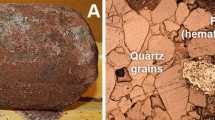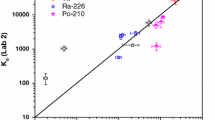Abstract
The use of generic sorption data in PA requires the transfer of the data to the PA-specific conditions. A site-specific Kd setting approach for PA calculations was tested, comparing two data transfer procedures. First transfer of sorption data can be done through semi-quantitative estimation procedures, by considering differences between experimental and PA geochemical conditions (sorption capacity, radionuclide speciation, competitive reactions, etc.). On the other hand, thermodynamic sorption models allow to estimate Kd variations directly, based on quasi-mechanistic understanding. The present paper focuses on illustrating example calculations regarding the derivation of Kd values, and their uncertainties, of Cs, Ni, Am and Th, for the mineralogical and geochemical conditions of the mudstone system at the Horonobe URL. Clay minerals (illite and smectite) were considered as sorption-relevant minerals in all cases. The Kd setting results were compared with Kd measured for Horonobe mudstone by batch experiments. The results indicate that Kd can be quantitatively evaluated from generic sorption data when adequate data and models are available. The careful evaluation and conjunctive use of calculated and measured Kd values can enhance the reliability of Kd setting and uncertainty assessments.
Similar content being viewed by others
References
M.H. Bradbury, B. Baeyens, PSI Bericht Nr. 03-08 (2003).
M. Ochs, C. Talerico, P. Sellin, A. Hedin, Phys. Chem. Earth, 31, 600–609 (2006).
OECD/NEA, NEA Sorption Project Phase III report (2012).
JAEA, Assessment Methodology of Chemical Effects on Geological Disposal System (2011, 2012).
M. Ochs, Y. Tachi, D. Trudel, T. Suyama, JAEA-Research 2012-044 (2013).
Y. Tachi, K. Yotsuji, Y. Seida, M. Yui, Geochim. Cosmochim. Acta 75, 6742–6759 (2011).
Y. Tachi, T. Suyama, M. Ochs, C. Ganter, JAEA-Data/Code 2010-03 (2011).
A. Kitamura, K. Fujiwara, R. Doi, Y. Yoshida, M. Mihara, M. Terashima, M. Yui, JAEA-Data/Code 2009-024 (2010).
H. Wanner, Y. Albinsson, E. Wieland, Fresenius J. Anal. Chem. 354, 763–769 (1996).
M.H. Bradbury, B. Baeyens, J. Contam. Hydrol. 42, 141–163 (2000).
D.L. Parkhurst, C.A.J. Appelo, User’s guide to PHREEQC (ver.2) (1999).
J.S. Wahlberg, M.J. Fishman, USGS Bull. 1140–A (1962).
Y. Tachi, K. Yotsuji, Y. Seida, M. Yui, Mater. Res. Soc. Symp. Proc. 1193, 545–552 (2009).
C. Poinssot, B. Baeyens, M.H. Bradbury, PSI Bericht Nr. 99-06 (1999).
J.A. Davis, J.A. Coston, D.B. Kent, C.C. Fuller, Environ. Sci. Technol. 32, 2820–2828 (1998). 10.1021/es980312q
M.H. Bradbury, B. Baeyens, Geochim. Cosmochim. Acta, 69, 875–892 (2005).
E. Tertre, G. Berger, S. Castet, M. Loubet, E. Giffaut, ibid, 69, 4937–4948 (2005).
M.H. Bradbury, B. Baeyens, ibid, 73, 990–1013 (2009).
L. Gorgeon, L. Ph.D. thesis. Université Paris 6 (1994).
M. Marques Fernandes, B. Baeyens, M.H. Bradbury, Radiochim. Acta 96, 691–697 (2008). 10.1524/ract.2008.1555
Acknowledgments
This study was partly funded by the Ministry of Economy, Trade and Industry of Japan. The experiments were partly performed by Tokyo Nuclear Service Inc. and Mitsubishi Material Corporation. This study was supported by the Horonobe Underground Research Center, JAEA.
Author information
Authors and Affiliations
Rights and permissions
About this article
Cite this article
Tachi, Y., Ochs, M., Suyama, T. et al. Kd setting approach through semi-quantitative estimation procedures and thermodynamic sorption models: A case study for Horonobe URL conditions. MRS Online Proceedings Library 1665, 149–155 (2014). https://doi.org/10.1557/opl.2014.640
Published:
Issue Date:
DOI: https://doi.org/10.1557/opl.2014.640




